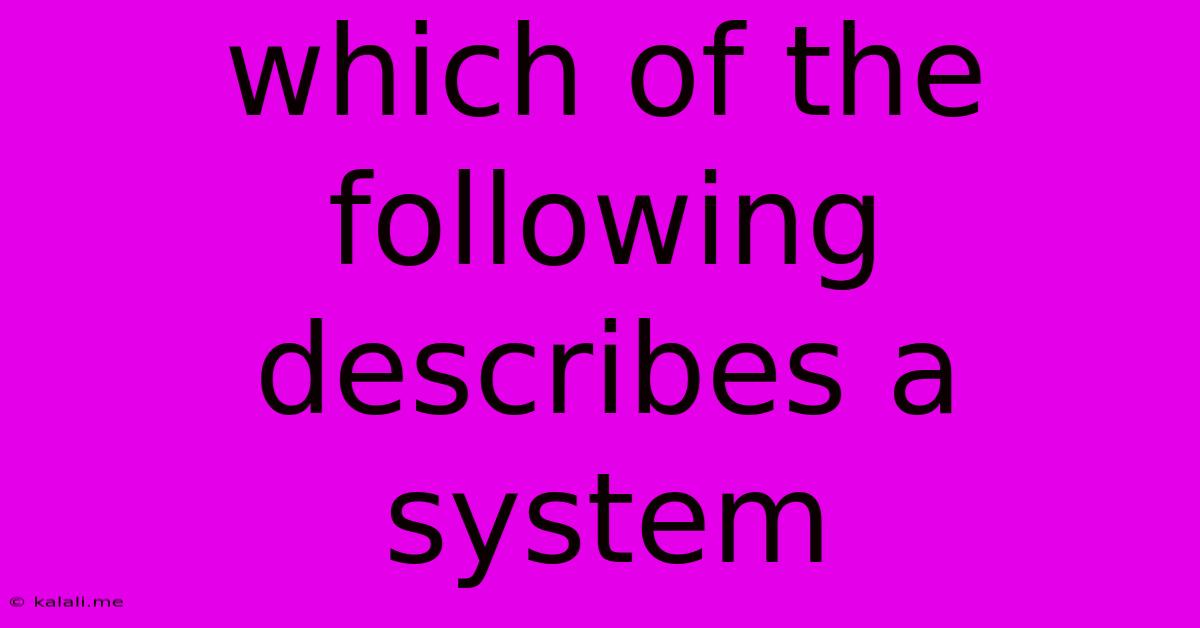Which Of The Following Describes A System
Kalali
Jun 14, 2025 · 3 min read

Table of Contents
Which of the Following Describes a System? Understanding Systems Thinking
This article explores the fundamental concept of a "system" and how to identify it. We'll delve into the characteristics that define a system and differentiate it from a mere collection of components. Understanding systems thinking is crucial in various fields, from engineering and computer science to biology and social sciences. This article will help you determine what constitutes a system and what doesn't.
A system is more than just a group of things; it's an interconnected set of elements that work together to achieve a common goal or purpose. Think of a car, for example – it's not just a collection of parts; it's a system where the engine, transmission, wheels, and other components interact to provide transportation. This interconnectedness and shared purpose are key defining characteristics.
Key Characteristics of a System
Several characteristics help define a system:
-
Interdependence: Components within a system rely on each other. A change in one part often affects other parts. For example, in an ecosystem, the decline of a pollinator population can affect the plants it pollinates and the animals that rely on those plants.
-
Holism: The system is greater than the sum of its parts. The emergent properties arising from the interaction of components cannot be predicted solely from the understanding of individual components. For instance, the consciousness of a human brain arises from the complex interaction of neurons, not from the individual neurons themselves.
-
Boundaries: Systems have defined boundaries that separate them from their environment. These boundaries can be physical (like the cell membrane of a cell) or conceptual (like the boundaries of a business organization).
-
Inputs and Outputs: Systems receive inputs from their environment and produce outputs. For example, a manufacturing system receives raw materials as inputs and produces finished goods as outputs.
-
Feedback Loops: Systems use feedback loops to adjust their behavior. Positive feedback loops amplify changes, while negative feedback loops dampen changes, maintaining stability. Think of a thermostat controlling room temperature – a negative feedback loop.
Examples of Systems
To further illustrate, here are some examples of systems and non-systems:
Systems:
- The human body: A complex system with interconnected organs and systems working together to maintain life.
- An ecosystem: A network of living organisms and their physical environment interacting with each other.
- A computer network: A collection of interconnected computers and devices sharing resources and information.
- A supply chain: The network of organizations involved in the production and distribution of a product.
- A city: A complex system involving people, infrastructure, and resources.
Not Systems (or, at least, not clearly defined systems):
- A pile of bricks: A collection of similar objects, but lacking interdependence or a common purpose.
- A random assortment of tools: Similar to the pile of bricks, no clear interaction or shared function.
- A list of ingredients: The ingredients themselves are not interacting to achieve a goal until combined and processed in a recipe (which would then become a system).
Identifying a System: Applying the Characteristics
When determining whether something is a system, consider the characteristics outlined above. Does it exhibit interdependence, holism, defined boundaries, inputs and outputs, and feedback loops? If the answer is yes to most of these, then you're likely dealing with a system. If not, it’s more accurately described as a collection of unrelated elements.
Understanding what constitutes a system is vital for effective analysis and problem-solving across numerous domains. By applying systems thinking, you can gain a more holistic and comprehensive understanding of complex phenomena and improve your ability to make informed decisions.
Latest Posts
Latest Posts
-
What Two Numbers Multiply To 32
Jun 15, 2025
-
Respiratory System Questions And Answers Pdf
Jun 15, 2025
-
Which Of The Following Are Two Classes Of Resistors
Jun 15, 2025
-
A Student Has Successfully Passed 60 Percent
Jun 15, 2025
-
Least Common Multiple Of 6 15 And 9
Jun 15, 2025
Related Post
Thank you for visiting our website which covers about Which Of The Following Describes A System . We hope the information provided has been useful to you. Feel free to contact us if you have any questions or need further assistance. See you next time and don't miss to bookmark.